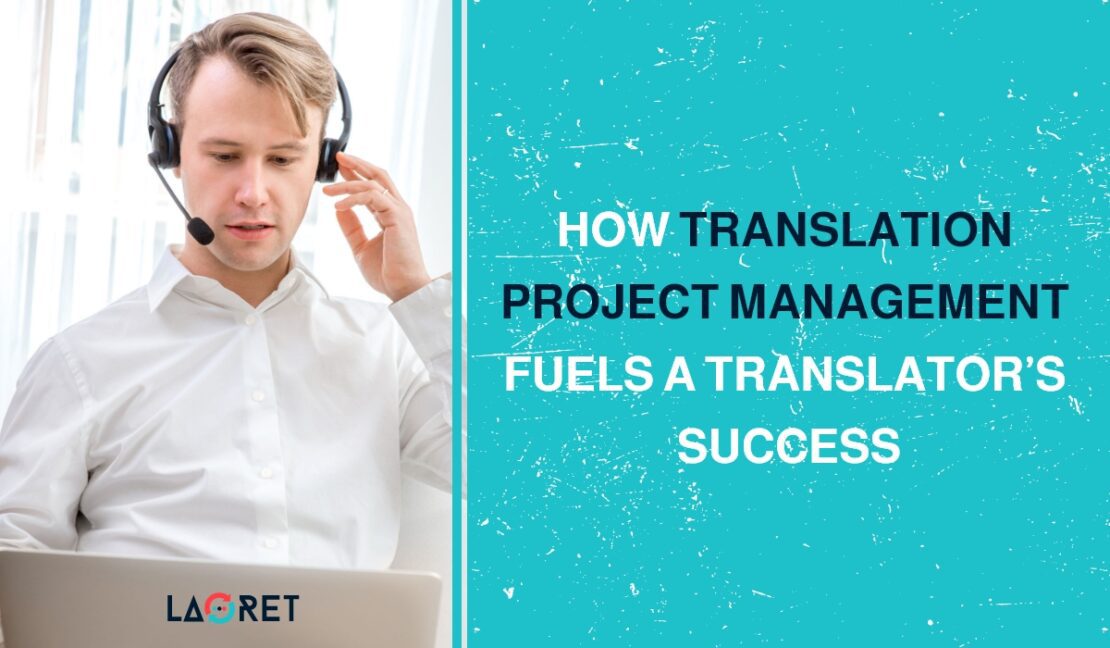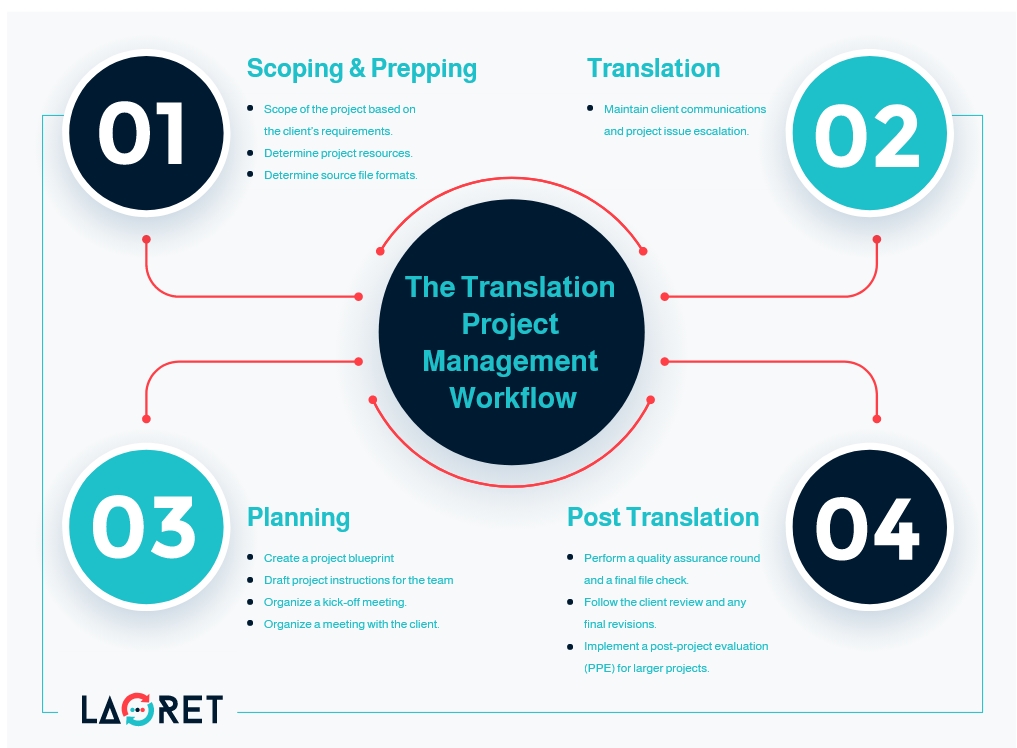How Translation Project Management Fuels A Translator’s Success
Being a translator is about more than just delivering a flawless piece of translated content. It is about time management, budgeting, communication, crisis control, and handling feedback.
Your love for languages and creativity has probably guided you towards a translation career. But what if you are not ready to handle all those other responsibilities?
Enter Translation Project Management!
Translation Project Management is one of the vital building blocks of a quality translation project. It ensures that communications, budgets, timelines, and teams are all perfectly aligned.
But beyond ensuring the perfect delivery of a timely and cost-effective product, project managers also drive translators to perform at their very best.
In this blog, we will zone in on the ins and outs of a project manager’s responsibilities, and explore how they will benefit YOU as a translator most.
What Is Translation Project Management?
Translation project Management refers to the operational framework that is essential to a translation or localization project’s success, which puts a professional project manager in charge to orchestrate the entire project from planning to completion and delivery.
The Project Manager follows a set of clear duties and responsibilities to ensure a project’s success. We will dive deeply into each of these in the next section, but at a glance these are:
- Scoping & Prepping: the project manager determines the resources needed for the translation project in terms of teams, budgets, and so on.
- Planning: A specific plan is drawn up and the team is briefed on the project.
- Translation: here, all communications are maintained and any issues with resources or timelines are resolved.
- Post Translation: QA is implemented and any feedback delivered by the client is processed.
The ultimate goal is to deliver the translation with little to no errors and perfectly in line with the client’s budget and requests. If this sounds like a very complicated task, it is because it definitely is.
The project manager is vital to a translation project’s success, and beyond eliminating and handling errors, the best project managers are capable of detecting early signs that a project may exceed the requested budget or timeline and will have to make choices accordingly. The complexity of the process will vary greatly depending on the project size and scope. It will be different for smaller projects because of how startups manage translations and large-scale localization that spans several languages and requires high levels of collaboration between a multidisciplinary team.
The Translation Project Management Workflow
Scoping & Prepping
- First of all, the Translation Project management preparation stage ensures that the project managers understand the full scope of the project based on the client’s requirements. They then refine these requirements and map out the best execution plan.
- Next, project resources are determined. Which team with what skillset will be needed? How many team members are required? Which resources and tools will be essential?
- The formats of source files, including all text and graphics, are determined. Depending on the format, specific software or an expert team of Desktop Publishing experts may be required.
Planning
- To make the entire process run smoothly, a Translation Project management system is leveraged to create a project blueprint. This way, the project manager will be able to track the budget and file life cycles throughout the localization process and set up a schedule.
- Project instructions are drafted for the team. Clear and straightforward milestones and steps are included in this, which will make the team’s job easier. This includes specific instructions communicated by the client as well as standards set by the translation project management team itself.
- A kick-off meeting is organized. Here, all questions are answered, and subject-matter experts can share their insights on the process.
- A subsequent meeting is held with the client, where the project manager clarifies how the objectives will be achieved and confirm the project deliverables. Any insights raised by the team will also be discussed and resolved.
Translation
- Throughout the project, translation project management tasks revolve around client communications and project issue escalation. The Project Managers will keep the clients up to date and are the primary contact for any issues that can arise. These communications will also be tracked and logged for future reference.
Post Translation
- Once the project is completed, the project manager performs a quality assurance round and a final file check and see if the source files and translated files are correct. The files will be set up for delivery according to the client’s preferred delivery channels.
- Then follows the client review and any final revisions that may be needed. The project manager will collate any changes requested by the client, communicate them to the production team, and then deliver the updated files to the client.
- For some of the larger projects, post-project evaluation (PPE) may be required where it is determined which changed the client requested and why and document all feedback as a reference for future projects in the translation project management system.
How Project Managers Support Translators in Doing the Best Possible Job
From the extensive Translation project Management workflow we have just discussed, you may have noticed that project managers are invaluable throughout the entire translation process. And because of this, they are indispensable to a translator’s success.
More than that, they are here to make a translator’s job easier and support you every step of the way, providing you with everything you need to succeed.Here are some key ways in which project managers make work (and life) just a little bit easier for translators like yourself, and how they support you in performing your very best work.
The Project Manager Puts Together the Translation & Localization A-Team
Translation projects vary from relatively simple and straightforward to highly complex.
Clients may, for example, require their software to be translated into 20 different languages. In this case, the project manager will be responsible for putting together the best possible translation team to get the job done according to the client’s expectations, budget, and timeframe.This will involve localization engineers, linguists, and Desktop Publishing experts, all of whom possess subject-matter expertise. You as a translator will play a vital role, and you will be selected based on your suitability. They will check on your expertise in the requested language pair, and how well you use Translation Tools, and confirm your experience in, in this case, software localization, to ensure you are capable of making the best translation choices.Being part of a team that includes editors, proofreaders, engineers, and more will allow you to be part of a project that delivers translations according to the highest quality standards. Beyond the QA delivered by the project manager, the proofreaders and editors will also ensure that the Translation, Editing, and Proofreading (TEP) process can be followed, as well as a linguist testing stage together with functionality and cosmetic testing.
Your Expertise is Respected and Used to the Fullest
We do not want to make it seem like project managers hold all the power here. Yes, they are the organizational powerhouse behind every project, but they know you have your own level of expertise that will need to be tapped.For example, as part of any translation project management workflow, there is typically a kick-off meeting with the internal team. Here, the project manager will make sure that every team member fully understands what the project involves and what the clients expect. During this meeting, all subject-matter experts, including you, are free to identify possible challenges or flag any issues that ought to be brought to the client’s attention. While from the localization engineer’s side this would include, for example, hardcoded images that feature non-translatable content, for you as translators, this can revolve around anything involving terminology issues and offering insights and advice on the best local interpretations of certain phrases.
Project Managers Are the Liaison Between You and Your Client
Communication is vital in any translation and localization project. But this means that tensions can also arise. Are you communicating fast enough? Diligently enough? Can you keep your cool and calm with the more difficult clients? You may relish the thought of interacting with clients yourself but for many translators, it can be a source of stress, and having someone speak on your behalf can be a welcome relief.Project Managers are the primary contact for clients, and they remain to be so along the way. This means that you, as a translator, will never need to deal with them directly. Project Managers, especially those part of a vendor, typically remain available 24/7 to answer any queries the clients may have and share status updates, customized reports, and so on.The parts of information that make it through to your end are those that will help you make your job easier and help you excel. As part of every Translation Project Management process, the project managers will create a project plan for the team. This will include instructions, milestones, and any standards the client has requested.
Efficient Translation Project Management Makes You a Better Translator
The Translation Industry is highly competitive, and you need to stay on top of your game to ensure consistent work for yourself. If you are part of a team selected by a project manager, you are given the tools and resources to excel at your job.The Translation Project Management team develops a customized workflow and provides you with resources clients have as a reference such as glossaries, style guides, demos, screenshots, and so on to ensure you have all you need to meet the client’s expectations.As part of a translation team, you will also be given access to the most advanced Translation CAT Tools. CAT tools increase efficiency and knowing how to use these will help you translate accurately and consistently while still committing to even the tightest deadlines. This is thanks to advanced features such as the Translation Memory, which will save all previously translated terms, and glossaries to maintain brand consistency.Additionally, the Translation Project Management team will continue to evaluate the workflow, tweaking it where needed, and provide targeted client feedback you will need to deliver top-quality translations.
Schedules and Timelines Are Taken Care of with no Hassle
Let’s face it, as a translator you need to excel at maintaining your schedule and meeting tight deadlines. But this is also what translation project management is all about. While you will still need to meet the milestones and timelines, the project managers are there to plan every step of the way.What’s more, they remain a point of contact if the work would prove to be too much to handle within the schedule and are capable of bringing in some extra muscle to get the jobs done successfully. So, make sure you fully use the project manager’s expertise and voice any concerns or issues you may have.
Conclusion
Translation Project Management is the robust framework that holds together any translation project. As a translator, the project manager will give you a solid structure to rely on and provide you with all the translation and localization resources you need to bring the project to a satisfactory end for everyone involved. They will further help you by organizing the schedule, communicating with the client on your behalf, and using your skills optimally. At Laoret, we hire native linguists with subject matter expertise to join our international teams and leverage cutting-edge CAT tools and projected management tools to streamline every project. Curious to find out more? Contact us and find out what we can do for you!







